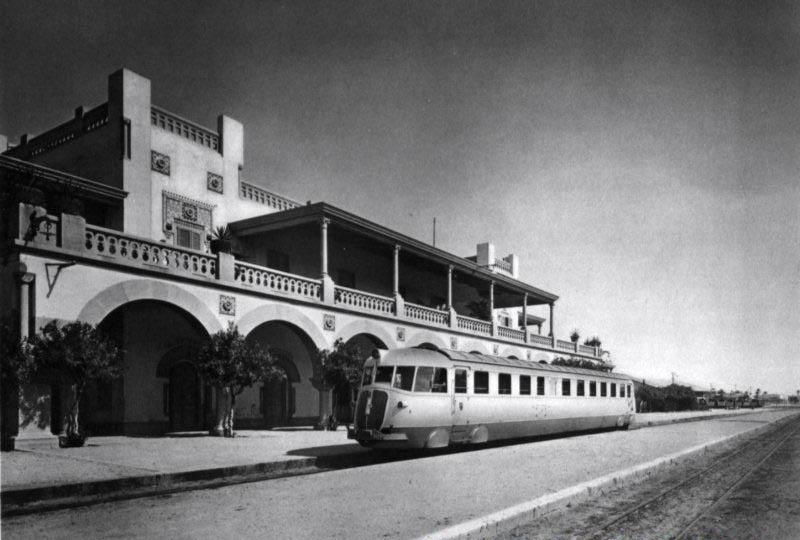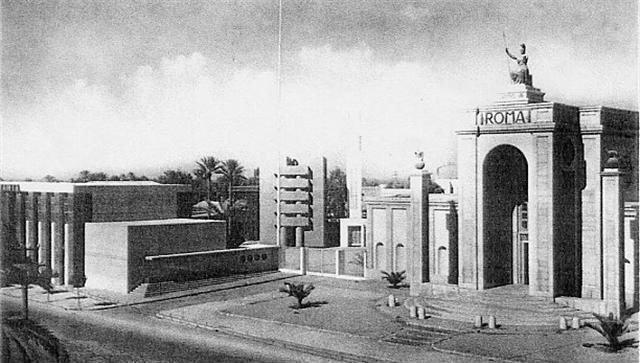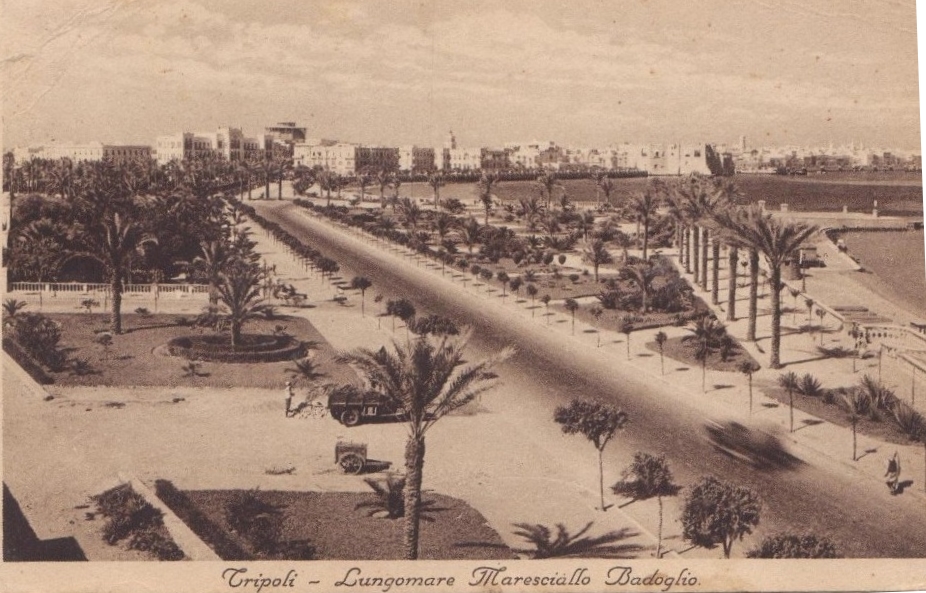This month I am going to research the "Italian Tripoli", capital of Italian Libya from 1911 to 1947.
Italian Tripoli was the capital of "Italian Libya". During the early XX century the city of Tripoli was under Italian control for 3 decades, that lasted from 1911 until January 1943. Italians conquered the town of less than 20,000 inhabitants from the Ottoman empire and enlarged it in 1943 to a big city of nearly 120,000 "Tripolini" (more than half Italians), creating a vibrant and modern capital in north Africa.
The census of 1939 showed this population in Tripoli:
Town...... Italians....... Arabs........ Jews........ Total
Tripoli... 47,442......... 47,123...... 18,467......113,212
Italian Tripoli was at the center of Italian NorthAfrica in the "Greater Italy" during WW2 (borders in orange color).With Decree of 9 January 1939 the four provinces of Tripoli, Misurata, Benghazi and Derna were aggregated to the Kingdom of Italy, becoming an integral part of the Italian metropolitan territory.
History
During the Italo-Turkish War of 1911 Tripoli was conquered by the Italian Kingdom. The Italian fleet appeared off Ottoman Tripoli in the evening of September 28, 1911: the city was quickly conquered by 1,500 Italian sailors, welcomed by the population (https://archive.org/details/tripoliitalianal00mart/page/36/mode/2upTripoli inhabitants welcomed the Italians; p. 36-40). The huge jewish community of Tripoli was very supportived of the Italian occupation (http://archive.diarna.org/site/detail/public/1784/).
TRIPOLI ITALIANA: The Grand Hotel, built in the early 1930
With the 1912 treaty signed in Ouchy, Italian sovereignty was acknowledged by the Ottomans, although the local Caliph was permitted to exercise religious authority. Italy officially granted autonomy after the war, but gradually occupied the region of Tripolitania. Originally administered as part of a single colony, Tripoli and its surrounding province were a separate colony from 26 June 1927 to 3 December 1934, when all Italian possessions in North Africa were merged into one colony called ''Libia''.
Since 1937 the governor Italo Balbo started a policy of immigration of Italians (mainly farmers) who were called the Ventimilli and some of them settled in the area of Italian Tripoli (https://www.youtube.com/watch?v=N_jA9rzM1MsVideo of Italian settlers arriving in the port of Tripoli).
Fiat train "Littorina" at Tripoli station
So, by the end of 1937, the city had 108,240 inhabitants, including 39,096 Italians (according to The Statesman's Yearbook 1948. Palgrave Macmillan. p. 1040). At the start of WWII Italian Tripoli had 111,124 inhabitants of which the Italians were 41,304: 37% of the city's inhabitants. Additionally there were nearly 18,000 Jews in the Tripoli area. Indeed after the Italian occupation of Libya in 1911, the Jews made great strides in education and economic conditions: at that time, there were about 21,000 Jews in the country, the majority in Tripoli. In the late 1930s, Fascist anti-Jewish laws were gradually enforced, and Jews were subject to moderate repression: still, by late 1940 -due even to the partial rejection of those laws by governor Italo Balbo- the Jews accounted for a fifth of the population of Tripoli and maintained 44 synagogues.
In 1942 Tripoli -according to estimates of the Italian government (Istituto Agricolo Coloniale (Firenze); Ministero degli Esteri, 1946)- reached a temporary population of nearly 150,000 inhabitants, due to the arrival of many Italians from Benghazi and Cyrenaica who took refuge from the British army attacks during WWII. As a consequence Tripoli was in that year -for the first time since the Arab conquest in 643 AD- a city mostly Christian.
Fiera internazionale di Tripoli ("Tripoli International Fair") in 1939
Architectural and Urbanistic improvement of Italian Tripoli
Tripoli underwent a huge architectural and urbanistic improvement under Italian rule (http://www.fedoa.unina.it/1881/1/Santoianni_Progettazione_Architettonica.pdf Tripoli section: p. 54-59). The first thing the Italians did was to create in the early 1920s a sewage system (that until then lacked) with water & electrical facilities to all the city and a modern hospital. Also was started the creation of the modern port.
Furthermore, in the western section of Tripoli was created an industrial area in the 1930s, around a huge tobacco factory (called "Manufattura Tabacchi di Tripoli"), with railway workshops, Fiat Motor works, various food processing plants, electrical engineering workshops, ironworks, water plants, agricultural machinery factories, breweries, distilleries, biscuit factories, tanneries, bakeries, lime, brick and cement works.
Governor Balbo used to say that "We Italians found in 1911 a big village of approximately 20,000 inhabitants called Tripoli and now we have in 1940 a modern capital nearly ten times bigger and one of the most developed and vibrant cities of Africa". (photos of Tripoli: http://www.paolocason.eu/Viaggio%20a%20Tripoli.htm ).
In the coast of the province was built in 1937-1938 a section of the Litoranea Balbia, a road that went from Tripoli and Tunisia's frontier to the border of Egypt. The car tag for the Italian province of Tripoli was "TL" (Berionne, Michele. "Libia (1937-1943)" Italian car tags )
Furthermore the Italians - in order to promote Tripoli's economy - founded in 1927 the "Tripoli International Fair", which is considered to be the oldest Trade Fair in Africa (http://tripolifair.com/tripoli-international-fair/ Tripoli International Fair brief history). The so-called Fiera internazionale di Tripoli was one of the main international "Fairs" in the colonial world in the 1930s, and was internationally promoted together with the Tripoli Grand Prix as a showcase of Italian Libya(http://cronologia.leonardo.it/storia/a1937f.htm Filippo Giannini: Colonial Italy and Islam (in Italian).
Italian Tripoli's Via Generale De Bono in 1933
Indeed the Italians even created the "Tripoli Grand Prix", an international motor racing event first held in 1925 on a racing circuit outside Tripoli that lasted until 1940 (https://www.youtube.com/watch?v=KEtz-wzbs9YVideo of Tripoli Grand Prix).Tripoli during the Grand Prix was visited by the elite tourism of the world and had even some "fashion" shops (https://www.pinterest.com/pin/187040190754209597/ Italian women walking near the Tripoli Castle in 1939).
The first airport in Libya, the "Mellaha Air Base" was built by the Italian Air Force in 1923 near the Tripoli racing circuit (actually is called "Mitiga International Airport"). The regular air services (with postal services) in Libya began in November 1928 with the first Rome-Syracuse-Tripoli air route, three times a week in winter, daily in summer, of the "Societa Anonima Navigazione Aerea (SANA)" airplanes. In the December of 1931 the "Società Nord Africa Aviazione (NAA)" inaugurated the Benghazi-Agedabia-Sirte-Tripoli line, which followed the coast line. With the absorption of the two companies from the ''Ala Littoria'' in 1935 the service continued on the same routes. From 4 April 1937 the Rome-Tunis line of Ala Littoria was extended to Tripoli; in 1938 the Air France opened a Marseilles-Tripoli line, then extended to Benghazi and Damascus. (www.academia.edu/2326842/ Le Poste italiane fuori dI'talia).
Tripoli had even a modern railway station with some small railway connections to nearby cities, when in August 1941 the Italians started to build a new 1,040 kilometres (646 miles) railway (with a 1,435 mm (56.5 in) gauge, like the one used in Egypt and Tunisia) between Tripoli and Benghazi. But the war -with the defeat of the Italian Army- stopped the construction the next year: only one hundred miles were created, but it was done also the project to connect this new railway with the borders of Tunisia & Egypt.
Banca d'Italia in 1932
Tripoli was controlled by Italy until 1943 when the provinces of Tripolitania and Cyrenaica were captured by Allied forces. The city fell to troops of the British Eighth Army on 23 January 1943 and the Italian colonists since then started to diminish (the following photo shows a family of farm colonists with British soldiers).
Tripoli was then governed by the British until independence in 1951. Under the terms of the 1947 peace treaty with the Allies, Italy relinquished all claims to Libya.
After WWII the era of international decolonization fostered a huge exodus of Italians from Tripoli (http://intranet.istoreto.it/esodo/parola.asp?id_parola=25https://books.google.com/books?id=ax0EpcZqeMkC&pg=PA12&lpg=PA12&dq=gheddafi+expulsion+of+italians&source=bl&ots=OYfkJX6Gd-&sig=7jgJ5We-toLe59m-eIyoYaBjjik&hl=en&sa=X&ei=PMEyVJnpE9C8ggSbzYGIBg#v=onepage&q=gheddafi%20expulsion%20of%20italians&f=false. Gaddafi expulsion of the Italians in 1970).
At present, the Libyan Italians are organized in the Associazione Italiani Rimpatriati dalla Libia (. http://www.airl.it Associazione Italiani Rimpatriati dalla Libia). The remaining "Tripolini" struggle to get their confiscated properties (http://www.airl.it/la-nostra-storia#eventistorici History of the Italian refugees from Gheddafi Libya) and even to maintain their Italian cemetery (www.corriere.it/esteri/16_aprile_10/cimitero-italiano-tripoli-sterpaglie-croci-divelte-devastazioni-70e3480c-ff61-11e5-a032-8e8dfe3b8a86.shtml Attacks on the Tripoli Italian Cemetery)
Infrastructures
Since the first years in Italian Tripoli were made many infrastructures by the Italians, even with the participation of the local arab "elite" (Journal of Libyan Studies 3, 1 (2002) p. 59-68: "Local Elites and Italian Town Planning Procedures in Early Colonial Tripoli (1911-1912)" by Denis Bocquet and Nora Lafi). The most important were the coastal road (called "Via Balbia" in honor of Italo Balbo after his death in 1940) between Tripoli and Benghazi and the railways Tripoli-Zuara, Tripoli-Garian and Tripoli-Tagiura.
The Cathedral of Tripoli (in the 1960s.
Other important infrastructures were the enlargement of the port of Tripoli with the addition of a seaplane facility and the creation of the Tripoli airport (later in the 1930s was added another "international" airport in nearby Castel Benito).
The first modern hospital in Tripoli was created by the Italians: the "Tripoli Central Hospital" main buildings that are standing now were built during the Italian administration of Libya in the 1910s. It was known then as L'Ospedale Coloniale di Vittorio Emanuele III (or Vittorio Emanuele III Colonial Hospital). The service during those days used to be headed by Italian doctors: notable among them was Tomaso Casoni (1880–1933) who practiced there from 1912 to 1932. He described there a test for diagnosing hydatid disease based on "dermal hypersensitivity", known internationally after him as the Casoni test. The original building is still standing and is occupied by the hospital's surgery department.
Since 1912 the Italian authorities started creating a "city plan", that was one of the first in the world to respect the ancient medieval city called "medina" (without demolitions of old buildings): it was decided to create a new modern city outside the Ottoman walls (http://www.fedoa.unina.it/1881/1/Santoianni_Progettazione_Architettonica.pdf Section: Tripoli, un centro di sperimentazione urbanistica e architettonica, p. 104). Tripoli city plan and architectural development by Italy). The city of Tripoli underwent a huge transformation in those years, with the creation of new avenues, squares, sea promenades and modern buildings like -to name a few worldwide famous- the modern "Palazzo delle Poste" and the "Palazzo Previdenza Sociale".
Lungomare Badoglio in 1940
From the central square "Piazza Italia", located just south of the old castle and medina, were created huge boulevards, like Corso Sicilia and Lungomare Badoglio (above is the photo of Lungomarfe Baxoglio in 1940), Corso Vittorio Emanuele III, Via Roma, Via Lazio, Via Piemonte and Via Lombardia around which new Italian-style modern buildings were developed. The buildings of the "Cassa di risparmio della Tripolitania" and of the "Banca d'Italia" were created as masterpieces of rationalist style (and are still used by the Central Bank of Libya).
In Tripoli was built in 1928 the biggest catholic cathedral of north Africa: the "Tripoli Cathedral". Italian government even restructured the ancient "Arch of Marcus Aurelius".
Indeed immediately after the Italian conquest, this Roman monument (related to M. Aurelius) received conservation and restoration work from the Italian administration, while the zone around the arch was reorganized by the Italian architect Florestano Di Fausto in the early 1930s. Governor Balbo gave Di Fausto in 1938 the task of designing the city plan of Italian Tripoli, and Di Fausto, nominated by Balbo chef of the "Commission for Urban Protection and Esthetics", with the main task of designing Tripoli's city plan, started to produce a stream of projects for Libya's capital: there the architect outlined the plan of Piazza Castello (the area around the Red Castle) and of the square around the Arch of Marcus Aurelius, in the Medina. Moreover, he erected public buildings, churches, markets, hotels, totaling fifteen works in few years(http://www.artefascista.it/tripoli__fascismo__architettu.htm Architecture in Tripoli created during Fascism Architecture in Tripoli created during Fascism).
"Piazza Italia" with Italian Renaissance style fountain and buildings
His masterpiece in Tripoli was the multifunctional center "Al Waddan" (hotel, swimming pools, casino, theater), characterized by a long row of arches parallel to today's Sharia al Fatah promenade: it was one of the predecessors of "modern malls". Indeed the actual Al Waddan opened in 1936 as the "Uaddan Hotel & Casino", just east of the Grand Hotel Tripoli (now destroyed as it was when originally built in 1925). Historically it was the grandest hotel in Tripoli and was referenced by an American journalist as being "the Waldorf Astoria of Tripoli" and was also named "a jewel of modern African architecture" (Segrè, Claudio G. Italo Balbo: A Fascist Life. University of California Press. p. 303. ISBN 978-0-520-07199-5). It contained a casino and a 500 seat theatre.
Di Fausto also created the famous "Hotel Del Mehari", built in 1935 at the same time as the nearby Hotel Casinò Uaddan. According to Brian McLaren in his book Architecture and tourism in Italian colonial Libya (https://books.google.com/books?id=_lrYlxdX7DIC&pg=PA194#v=onepage&q&f=false), the (destroyed after WW2) Mehari hotel "provided a fusion of the indigenous architecture of Tripoli with a modern aesthetic that responded to the demand for a metropolitan standard of comfort, typical to colonial tourism"
In all these works, the architect Di Fausto resumed his Romano-Greek experience, mixing with great virtuosity arabisant and novecento elements.
Even the modern futuristic "Church of Saint Francis" in downtown Tripoli was another work of art of him. The same residence of Governor Balbo was to become after WWII the "Royal Palace" of the Libya's king. Balbo even promoted the creation of an international airport at "Castel Benito" (now called Tripoli International Airport), connected by the first international flights in Africa to Italy and to Ethiopia's Addis Abeba. The Red Castle Museum was established in 1919, when the colonial Italians in Libya converted a section of the Tripoli's ancient castle to a museum to house many of the archaeological artifacts scattered across the country since prehistoric times. The square around the castle was designed in the thirties by architect Di Fausto as "Piazza Castello" and was integrated with nearby "Piazza Italia" and the disappeared "Lungomare Conte Volpi".
In 1939 was created the '7 October Stadium', a grass football stadium called initially "Stadio Comunale di Tripoli" and based in the center of the city. The stadium was initially made for 5,000 people and was used even for athletism and cyclism sports. It was the only football stadium in Tripoli before the June 11 Stadium was built in the 1970s.
The "Palazzo del Governatore" of Balbo, remodeled as Royal Palace in the 1950s
The Piazza Italia (now called Martyr's Square) featured on one side a wide avenue leading towards the seafront with two tall pillars. On top of the pillars still there are an iron-cast, miniature wooden ship on the norther corner, while the other one features a horseback rider. On the Piazza's other side there was the Teatro Miramare, called later Royal Miramare Theatre: it used to be located across from the Red Castle Museum, but it was demolished by Gaddafi's government after the 1960s to create space for large demonstrations. Another important building demolished by dictator Gheddafi was the Tripoli railway station, built in 1937. It was the only railway station in Africa served by the state-of-the-art "Littorina" (an Italian passenger train that obtained the world record of speed in 1939 with the model FS Class ETR 200).
Additionally, a group of villages for Italians and Libyans were created on the coastal tripolitania around Italian Tripoli during the 1930s. They were like satellite towns and interacted with Tripoli (http://www.qattara.it/balbia_files/Opere%20italiane%20in%20Africa.pdf Photos of Italian works in Libya and of the new villages created for Italians and Libyans). In 1939 the most important created and populated only by native arabs and berbers (who received by governor Italo Balbo the Italian citizenship in the newly created "Quarta Sponda" or "Fourth Shore of Italy") were: "El Fager" (al-Fajr, Alba in Italian language), "Nahima" (Deliziosa), "Azizia" (‘Aziziyya, Meravigliosa), "Nahiba" (Risorta), "Mansura" (Vittoriosa), "Chadra" (khadra, Verde), "Zahara" (Zahra, Fiorita), "Gedida" (Jadida, Nuova), "Mamhura" (Fiorente).
All the villages in the outskirts of Tripoli since 1939 were connected daily by bus service to the "Stazione centrale autobus" (one of the first central bus stations in north Africa), located in the square of the Tripoli Railway Station.
Corso Vittorio Emanuele in 1936
LINKS
1)"Atlante delle colonie italiane". Detailed Atlas of Italian colonies, written by Baratta Mario and Visintin Luigi in 1928 (https://historica.unibo.it/explore?bitstream_id=767002&handle=20.500.14008/78925&provider=iiif-image&viewer=mirador)
2)Italian senate photo archive: Tripoli (https://patrimonio.archivioluce.com/luce-web/search/result.html?query=&jsonVal=%7B%22jsonVal%22%3A%7B%22query%22%3A%5B%22tripoli+%22%5D%2C%22fieldDate%22%3A%22dataNormal%22%2C%22_perPage%22%3A20%7D%7D&activeFilter=temi&luoghi=%22Tripoli%22&activeFilter=luoghi)
3)Italo Balbo: LA COLONIZZAZIONE DEMOGRAFICA IN LIBIA (1939)
( http://epa.oszk.hu/02500/02510/00033/pdf/EPA02510_corvina_1939_04_281-291.pdfhttp://epa.oszk.hu/02500/02510/00033/pdf/EPA02510_corvina_1939_04_281-291.pdf )
4)Video of Tripoli in 1936 (https://www.youtube.com/watch?v=7kU8WsW2Eiw)
5)Video of "Fiera di Tripoli" in 1939 (https://www.youtube.com/watch?v=RTFIvuUb9eo)










